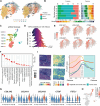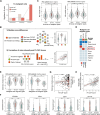Spatial multiomics reveals a subpopulation of fibroblasts associated with cancer stemness in human hepatocellular carcinoma
- PMID: 39138551
- PMCID: PMC11320883
- DOI: 10.1186/s13073-024-01367-8
Spatial multiomics reveals a subpopulation of fibroblasts associated with cancer stemness in human hepatocellular carcinoma
Abstract
Background: Cancer-associated fibroblasts (CAFs) are the prominent cell type in the tumor microenvironment (TME), and CAF subsets have been identified in various tumors. However, how CAFs spatially coordinate other cell populations within the liver TME to promote cancer progression remains unclear.
Methods: We combined multi-region proteomics (6 patients, 24 samples), 10X Genomics Visium spatial transcriptomics (11 patients, 25 samples), and multiplexed imaging (92 patients, 264 samples) technologies to decipher the expression heterogeneity, functional diversity, spatial distribution, colocalization, and interaction of fibroblasts. The newly identified CAF subpopulation was validated by cells isolated from 5 liver cancer patients and in vitro functional assays.
Results: We identified a liver CAF subpopulation, marked by the expression of COL1A2, COL4A1, COL4A2, CTGF, and FSTL1, and named F5-CAF. F5-CAF is preferentially located within and around tumor nests and colocalizes with cancer cells with higher stemness in hepatocellular carcinoma (HCC). Multiplexed staining of 92 patients and the bulk transcriptome of 371 patients demonstrated that the abundance of F5-CAFs in HCC was associated with a worse prognosis. Further in vitro experiments showed that F5-CAFs isolated from liver cancer patients can promote the proliferation and stemness of HCC cells.
Conclusions: We identified a CAF subpopulation F5-CAF in liver cancer, which is associated with cancer stemness and unfavorable prognosis. Our results provide potential mechanisms by which the CAF subset in the TME promotes the development of liver cancer by supporting the survival of cancer stem cells.
Keywords: Cancer stem cell; Cancer-associated fibroblast; Liver cancer; Spatial transcriptomics; Tumor microenvironment.
© 2024. The Author(s).
Conflict of interest statement
The authors declare that they have no competing interests.
Figures







References
MeSH terms
Grants and funding
- 2021YFF1200900/the National Key R&D Program of China
- 81972644/the National Natural Science Foundation of China
- 82372729/the National Natural Science Foundation of China
- T2122018/the National Natural Science Foundation of China
- 32170680/the National Natural Science Foundation of China
- 91859205/the National Natural Science Foundation of China
- 81830054/the National Natural Science Foundation of China
- 81988101/the National Natural Science Foundation of China
- U21A20376/the National Natural Science Foundation of China
- 2018ZX10723204/the National Science and Technology Major Project of China
- 2018307/CAS Youth Innovation Promotion Association
- 21XD1404600/the National Science Foundation of Shanghai
- 21JC1406600/the National Science Foundation of Shanghai
- 22140901000/the National Science Foundation of Shanghai
- 2020-ZD-01/Key Project of Jiading District Health Construction Commission of Shanghai
- 2021MS15/the Basic Medical Research Foundation of the Naval Medical University
- 2022yx005/the Basic Medical Research Foundation of the Naval Medical University
LinkOut - more resources
Full Text Sources
Medical
Miscellaneous

